Rainbow hematite is a form of hematite, a common iron oxide mineral with the chemical formula Fe2O3. What sets rainbow hematite apart from typical hematite is its captivating iridescent or rainbow-like sheen. This iridescence is caused by the presence of a thin layer of microscopic platelets or scales on the surface of the mineral. These platelets interact with light, creating a play of colors that can resemble the colors of the rainbow. The colors often seen on rainbow hematite include shades of blue, green, purple, and gold, and they can change when the mineral is viewed from different angles or under varying lighting conditions.
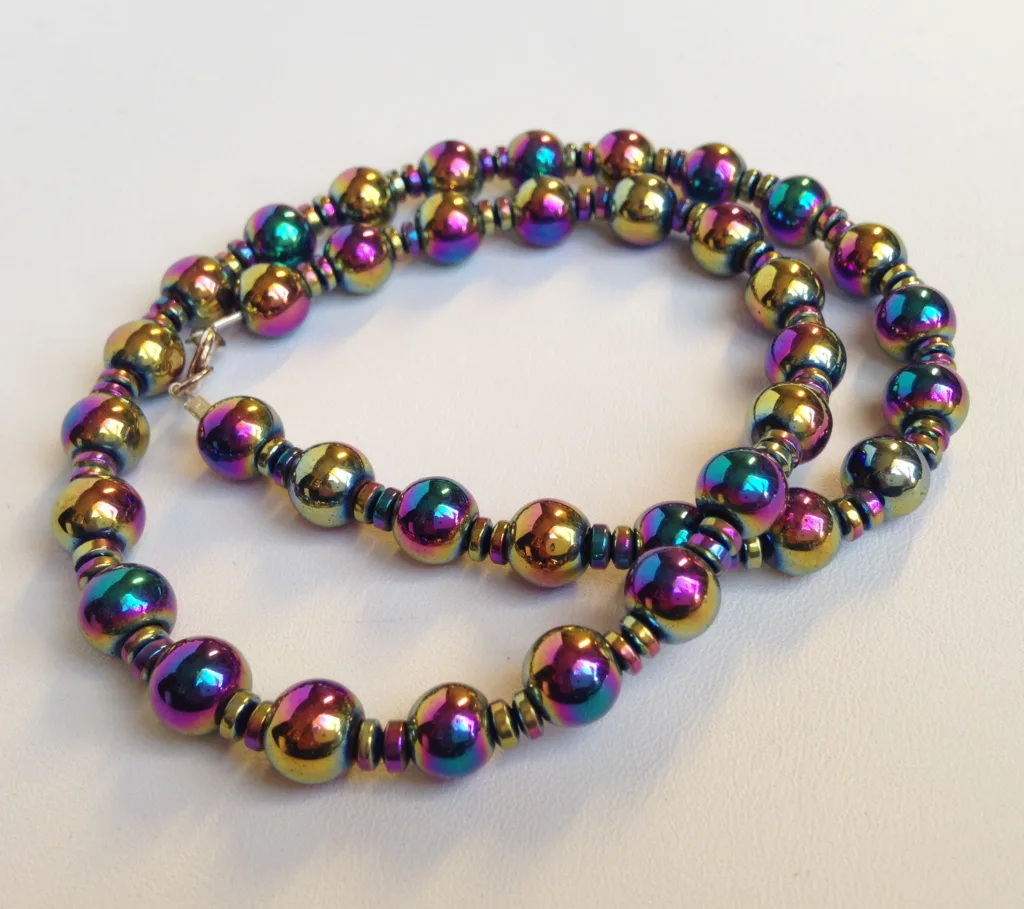
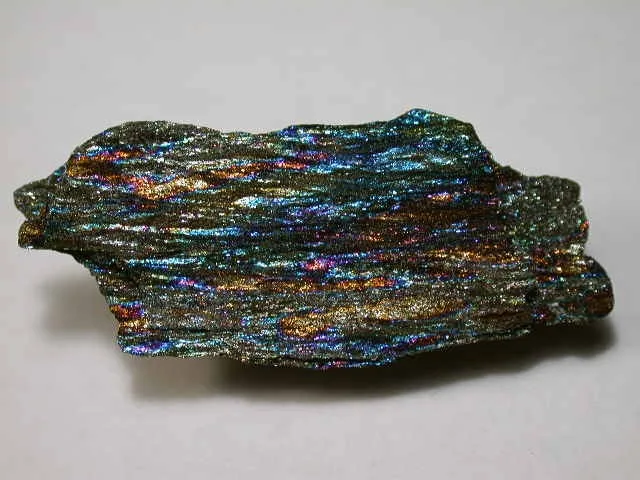
Rainbow hematite is typically found as botryoidal (grape-like) or reniform (kidney-shaped) masses with a metallic luster. Its iridescence can be quite striking and has made it a popular choice for jewelry and decorative pieces.
History and Discovery: The history of rainbow hematite is closely tied to the broader history of hematite itself, as they share a common mineralogical origin. Hematite has been used by humans for thousands of years for various purposes, including as a pigment for cave paintings and as a source of iron for tools and weapons.
The specific discovery and recognition of rainbow hematite as a distinct variety of hematite with its iridescent qualities are not well-documented. It is possible that individuals throughout history noticed the colorful sheen on certain hematite specimens and found them particularly attractive for ornamental and artistic purposes.
In more recent times, rainbow hematite has gained popularity as a decorative mineral and has been used in jewelry, beads, and lapidary work. Its colorful appearance and unique properties make it a sought-after collector’s item and a popular choice for jewelry designers and gem enthusiasts.
In summary, rainbow hematite is a type of hematite that stands out due to its remarkable iridescence, which results from the presence of thin surface platelets interacting with light. While the precise history of its discovery is not well-documented, its colorful and captivating appearance has made it a valued mineral for both collectors and artisans in recent years.
Physical and Chemical Properties of Rainbow Hematite

Rainbow hematite, like other varieties of hematite, possesses specific physical and chemical properties that distinguish it as a unique mineral. Here are some key physical and chemical properties of rainbow hematite:
Physical Properties:
- Color: The most distinctive feature of rainbow hematite is its iridescent or rainbow-like sheen. This iridescence can display a range of colors, including blue, green, purple, and gold. The colors can shift as the mineral is viewed from different angles or under varying lighting conditions.
- Luster: Rainbow hematite exhibits a metallic luster, giving it a shiny and reflective appearance.
- Streak: When scraped against an unglazed porcelain streak plate, rainbow hematite leaves a reddish-brown streak due to the presence of iron oxide.
- Hardness: Rainbow hematite has a hardness of about 5.5 to 6.5 on the Mohs scale of mineral hardness. This places it in the same hardness range as common minerals like quartz and feldspar.
- Cleavage: Rainbow hematite has no cleavage, meaning it does not break along specific planes. Instead, it exhibits a conchoidal fracture, which results in irregular, shell-like fractures when it is broken.
- Crystal System: Hematite, including rainbow hematite, crystallizes in the trigonal crystal system. However, rainbow hematite is often found as botryoidal (grape-like) or reniform (kidney-shaped) masses, rather than as distinct crystals.
- Density: The density of rainbow hematite typically ranges from 4.9 to 5.3 grams per cubic centimeter (g/cm³), depending on its specific composition and impurities.
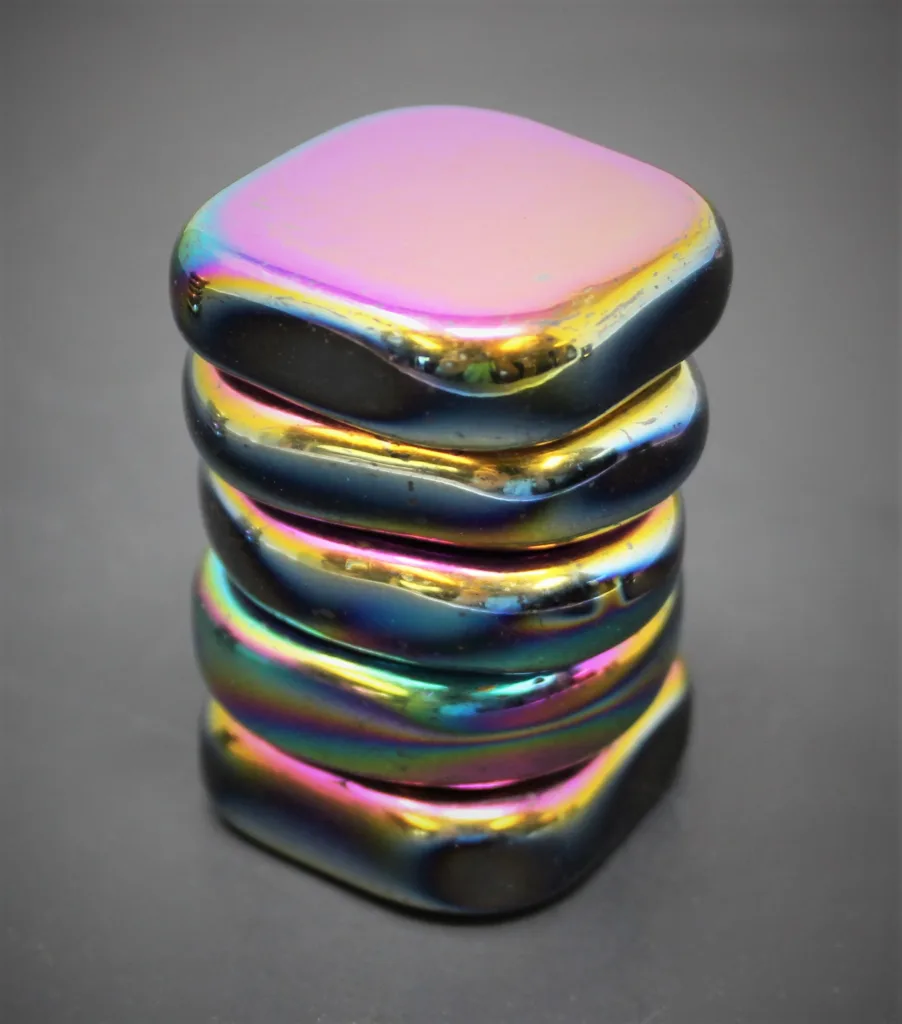
Chemical Properties:
- Chemical Formula: The chemical formula of rainbow hematite is Fe2O3, indicating that it is primarily composed of iron (Fe) and oxygen (O). It is an iron oxide mineral.
- Composition: Rainbow hematite is composed mainly of iron(III) oxide (Fe2O3). Its iridescent colors are a result of the thin layer of microscopic platelets on its surface, which interact with light to create the colorful sheen.
- Magnetism: Hematite, including rainbow hematite, is weakly magnetic. It can be attracted to a strong magnet, but its magnetism is not very pronounced.
- Transparency: Rainbow hematite is generally opaque, meaning that light does not pass through it.
- Lustre: As mentioned earlier, rainbow hematite exhibits a metallic lustre, which is characteristic of many metallic minerals.
- Mohs Hardness: Its Mohs hardness of 5.5 to 6.5 indicates that rainbow hematite is moderately hard and can scratch glass but can also be scratched by harder minerals.
These physical and chemical properties make rainbow hematite a unique and visually appealing variety of hematite, prized for its iridescence and often used in jewelry and decorative objects.
Formation and Occurrence
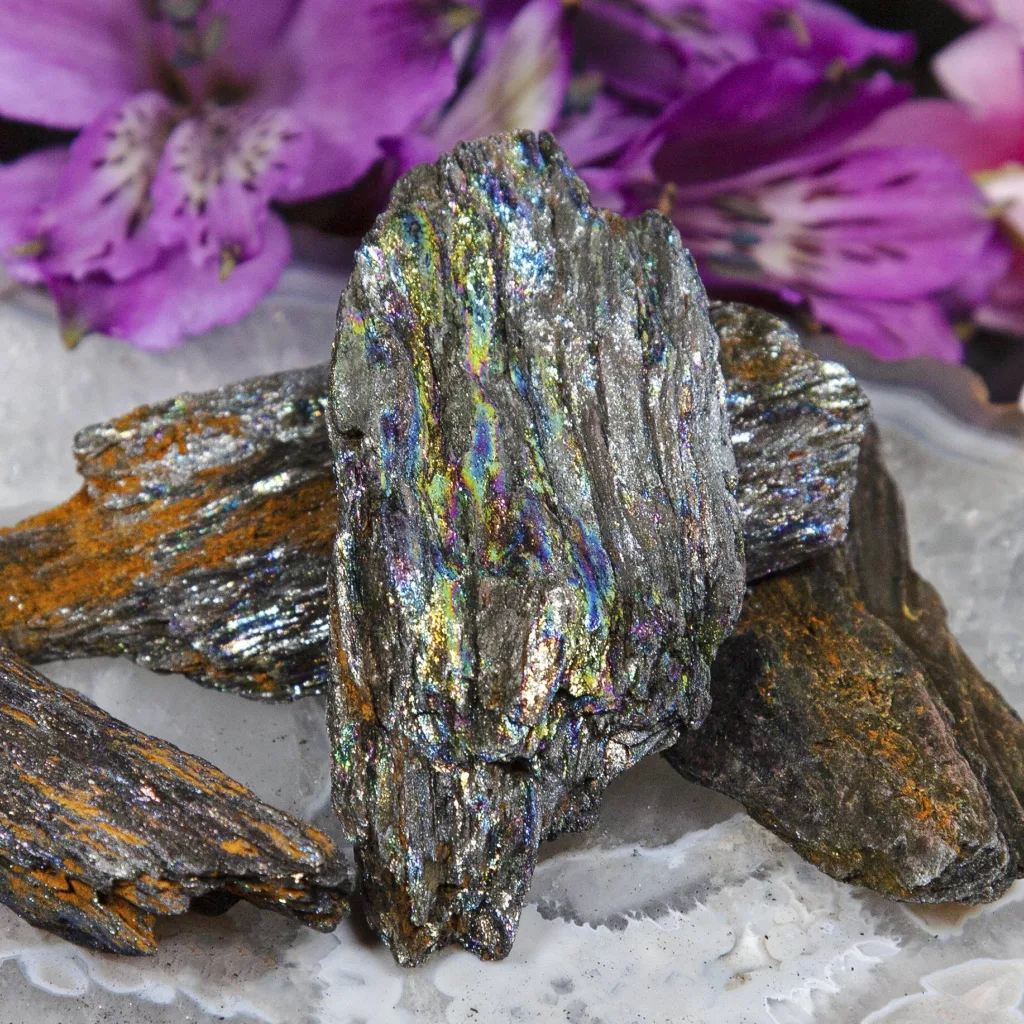
Rainbow hematite, like other forms of hematite, forms through various geological processes and can be found in different geological settings. Here’s an overview of its formation and occurrence:
Formation:
- Hydrothermal Processes: One common mode of formation for rainbow hematite is hydrothermal processes. In these settings, hot fluids rich in iron and other minerals percolate through rocks and deposit hematite as they cool and react with the surrounding rocks. The formation of the iridescent layer on rainbow hematite’s surface may be influenced by specific conditions during hydrothermal deposition.
- Weathering and Alteration: Hematite can also form as a result of weathering and alteration of other iron-rich minerals, such as magnetite or pyrite. In some cases, these weathering processes can result in the development of iridescent surface coatings on hematite.
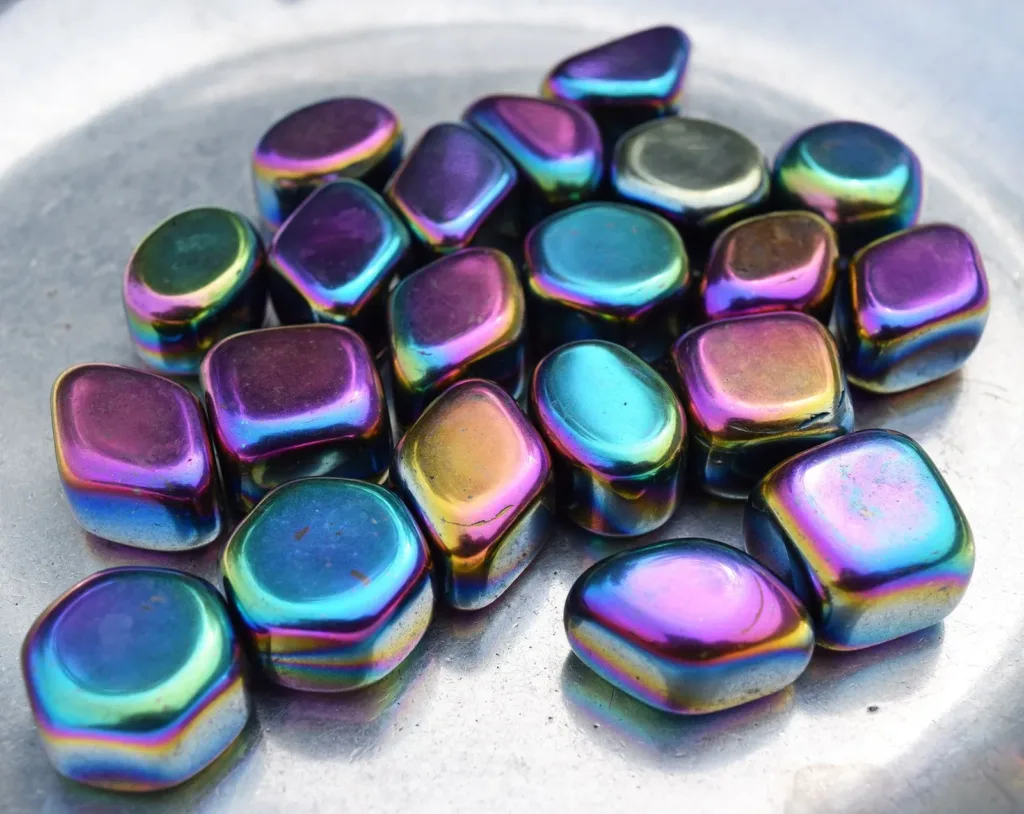
Occurrence: Rainbow hematite can be found in various geological settings around the world. Some common occurrences include:
- Sedimentary Rocks: Hematite, including rainbow hematite, is often found in sedimentary rocks such as sandstone, shale, and limestone. These rocks may contain hematite nodules or concretions that can exhibit iridescence.
- Hydrothermal Veins: Hydrothermal veins, which form as a result of hot fluids moving through fractures in rocks, can host rainbow hematite deposits. These veins may occur in various types of host rocks, including granite, quartzite, and schist.
- Ores: Hematite is a significant ore of iron, and rainbow hematite can sometimes be found within iron ore deposits. It is particularly common in banded iron formations (BIFs), which are sedimentary rocks that contain alternating layers of iron-rich and silica-rich minerals.
- Metamorphic Rocks: Hematite can also be present in metamorphic rocks, where high-pressure and temperature conditions have caused the mineral to recrystallize. In some cases, rainbow hematite may be found in these metamorphic settings.
- Weathered Environments: In some weathered environments, particularly those with iron-rich soils or sediments, rainbow hematite can be formed or exposed at the surface as a result of weathering and oxidation processes.
- Mineral Deposits: Rainbow hematite can occasionally be found in association with other minerals in mineral deposits. These occurrences may vary depending on the specific geological context of the deposit.
It’s important to note that while rainbow hematite is known for its iridescent surface, not all hematite specimens will exhibit this colorful sheen. The presence and intensity of the iridescence can vary depending on factors such as the mineral’s composition, the presence of impurities, and the specific geological conditions during its formation. Collectors and enthusiasts often seek out rainbow hematite for its striking appearance and unique visual appeal.
Rainbow Hematite’s Uses
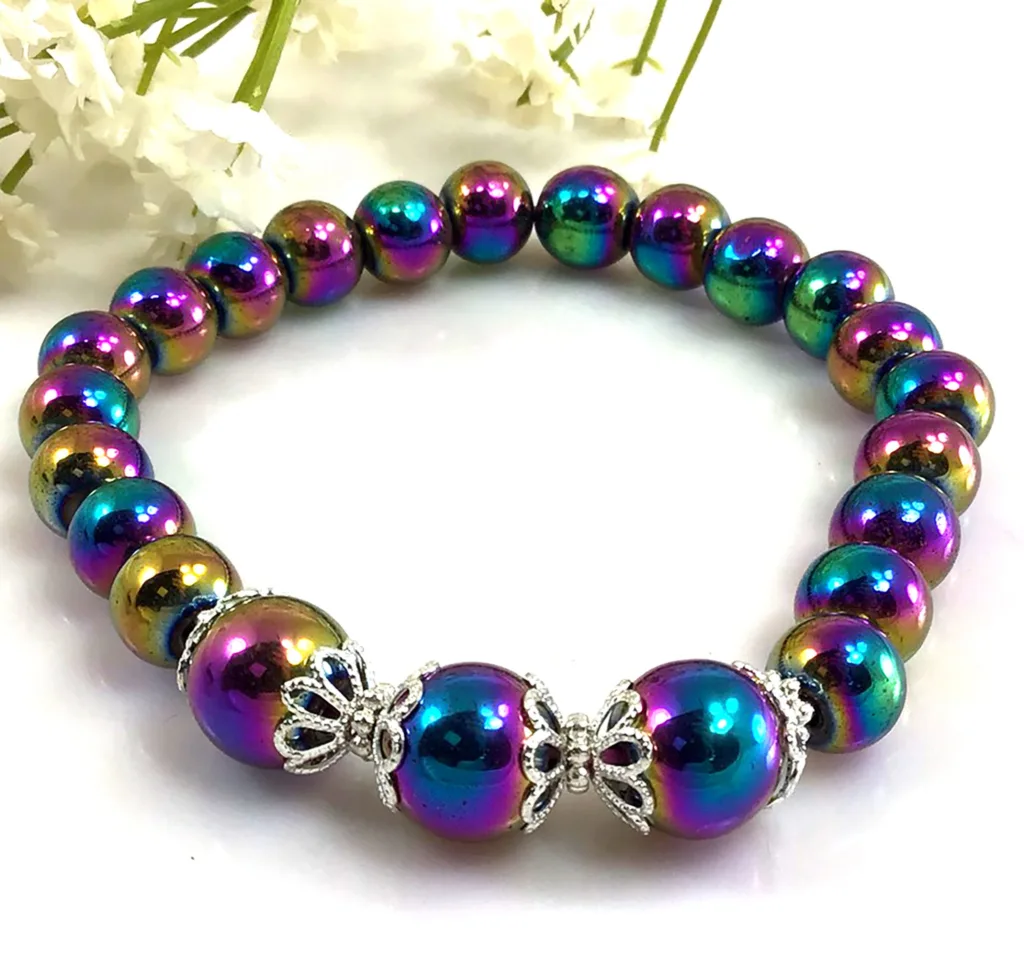
Rainbow hematite, with its unique iridescent appearance, has several practical and aesthetic uses. Here are some of the primary uses of rainbow hematite:
- Jewelry: Rainbow hematite is a popular choice for making jewelry due to its striking appearance. It is often used to create earrings, necklaces, bracelets, and pendants. The iridescent surface adds a vibrant and eye-catching element to jewelry designs.
- Ornamental and Decorative Objects: Rainbow hematite is used to craft ornamental and decorative objects such as bookends, paperweights, and figurines. Its iridescence makes it a valuable addition to art and décor, enhancing the visual appeal of these items.
- Collectibles: Rainbow hematite is a sought-after mineral specimen among collectors. Mineral collectors appreciate its unique and colorful appearance, often acquiring specimens for their private collections.
- Metaphysical and Spiritual Uses: Some individuals believe that rainbow hematite has metaphysical properties and spiritual significance. It is thought to be a stone that promotes balance, grounding, and protection. People may carry or wear rainbow hematite for its alleged healing and energy-balancing properties.
- Educational Purposes: Rainbow hematite is used in educational settings to teach students about minerals, geology, and the unique optical properties of iridescent minerals. It can be a valuable tool for demonstrating geological concepts.
- Lapidary and Cabochons: Skilled lapidaries can shape and polish rainbow hematite into cabochons or polished gemstones. These cabochons can be used in custom jewelry designs or incorporated into artistic creations.
- Meditation and Relaxation: Some individuals use rainbow hematite as a meditation aid, believing that it helps with relaxation and concentration during mindfulness practices.
- Feng Shui: In Feng Shui, rainbow hematite may be used for its energy-enhancing and balancing properties. It is sometimes placed in specific areas of the home or workspace to promote positive energy flow.
- Art and Craft Projects: Crafters and artists may incorporate rainbow hematite into various creative projects, including mosaics, sculpture, and mixed-media artworks, to add a touch of iridescence and visual interest.
- Geological and Mineralogical Research: Scientists and researchers may study rainbow hematite for its optical and structural properties. Understanding how the iridescence is generated can have applications in materials science and optics.
It’s important to note that while rainbow hematite has these various uses, its primary appeal lies in its aesthetic qualities. As with many gemstones and minerals, the perceived metaphysical and healing properties of rainbow hematite are subjective and not scientifically proven. Nevertheless, its stunning appearance makes it a popular choice for jewelry and decorative purposes.




































